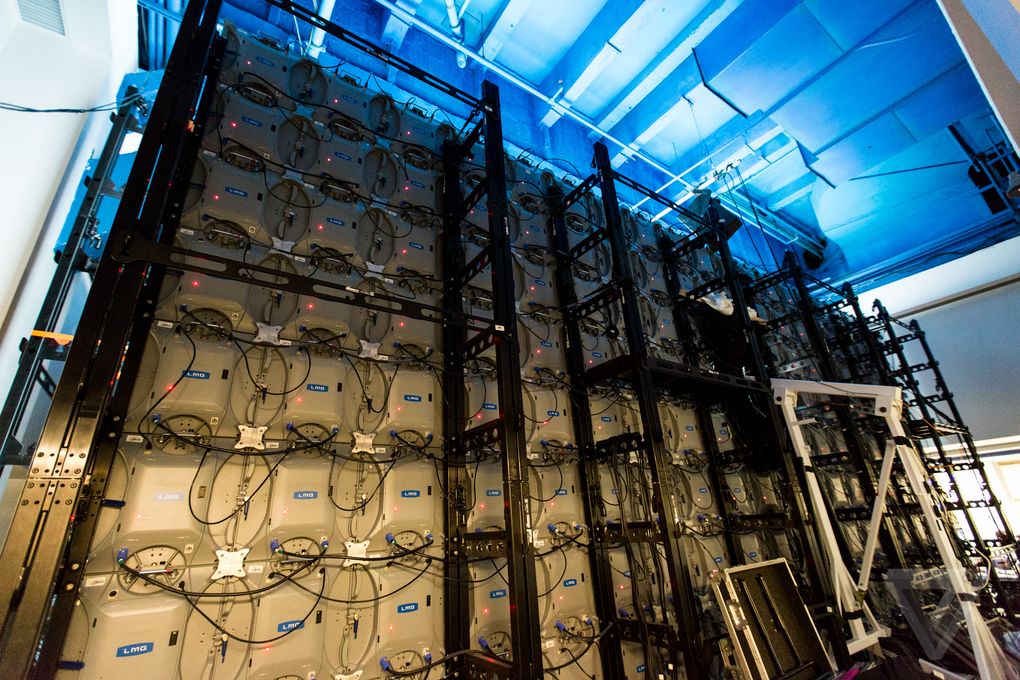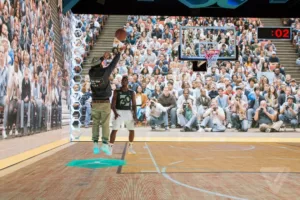The US National Basketball Association’s All-Star Game at New York’s Madison Square Garden and associated events held Feb. 13-15, 2015 provided a venue for a notable large format display application.

In conjunction with Nike’s Jordan brand, creative agency AKQA and video-production company Stardust developed and installed a very large format interactive display application across the street from Madison Square Garden. The design and use of the virtual reality installation has been reported by The Verge and Wired. The display application consisted of a 1200 square foot (111 m²) “half-court” room with tiled LED displays on the floor and three walls (photo below).
Source: The Verge
In operation, the virtual reality installation called “The Last Shot,” was programmed to let users experience two of basketball legend Michael Jordan’s most iconic moments: Jordan’s go-ahead shot to beat Georgetown in the 1982 NCAA finals or his game-winning shot against the Utah Jazz in the 1998 NBA Finals. The photo above shows the simulated crowd of spectators lining the basketball court. The parquet floor of the court is rendered and the green spot on the floor shows the user where to take his shot at the basket. The Verge termed the display “an NBA holodeck”. A popular search term for the virtual reality installation is “Michael Jordan Simulator”. The video embedded below gives an impression of the NBA holodeck in action.
The four video walls/floor of the virtual reality installation were comprised of about 10 million LEDs arranged in nearly 1000 tiles. The tiling of the LED display modules is illustrated in the photo below showing the backplane of the display wall.
 Source: The Verge
Source: The Verge
LED tiles are supplied by LMG, a US provider of video, audio and lighting support. As shown in the photo above, the LMG supplied LED tiles appear to be 3.9 mm LED pitch modules consisting of 128 x 128 RGB pixels. Other specifications for the LED tiles include: brightness: 1300 cd/m²; weight: 18.7lbs (8.5kg); frame size: 500mm x 500mm x 84mm; viewing angle: 120° horizontal, 100° vertical; power: 55W typical, 165W max. The panels are specified for indoor use only.
In describing the user experience of the simulator, Wired reported that, “When the experience kicks in, it’s like a video game augmenting real life. A path lights up on the ground to show you where to go. On each wall, 4k footage of a real crowd cheers or boos depending on whether you deliver. In the Utah scenario, the “home crowd” cheers when you miss – a nice touch. A real play-by-play announcer calls out your every move, and real players on the court deliver that key assist, play defense and act as stand-ins for Byron Russell, playing along when you push off”.
While the NBA holodeck is impressive, the cost (and power consumption) of mounting such an event is large, and the flexibility and range of applicability of such an installation are limited. Nevertheless, with the creative efforts of the content developers and the popular appeal of such a virtual reality user experience we should expect to see more widespread applications of high quality large format displays. – Phil Wright

